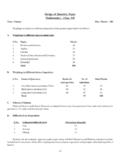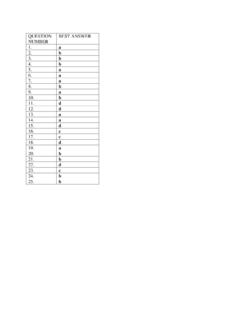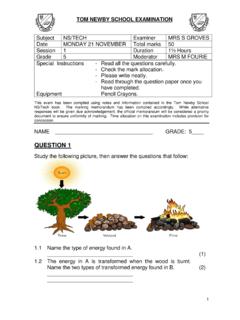Transcription of GCSE Biology Specimen question paper Paper 1
1 Specimen MATERIAL GCSE Biology Higher Tier Paper 1H Specimen 2018 Time allowed: 1 hour 45 minutes Materials For this Paper you must have: a ruler a calculator. Instructions Answer all questions in the spaces provided. Do all rough work in this book. Cross through any work you do not want to be marked. Information There are 100 marks available on this Paper . The marks for questions are shown in brackets. You are expected to use a calculator where appropriate. You are reminded of the need for good English and clear presentation in your answers. When answering questions , , and 10 you need to make sure that your answer: is clear, logical, sensibly structured fully meets the requirements of the question shows that each separate point or step supports the overall answer.
2 Advice In all calculations, show clearly how you work out your answer. H Please write clearly, in block capitals. Centre number Candidate number Surname Forename(s) Candidate signature 2 Specimen MATERIAL There are no questions printed on this page 3 Specimen MATERIAL 0 1 Plants transport water and mineral ions from the roots to the leaves. 0 1 . 1 Plants move mineral ions: from a low concentration in the soil to a high concentration in the root cells. What process do plants use to move these minerals ions into root cells? [1 mark] Tick one box.
3 Active transport Diffusion Evaporation Osmosis 0 1 . 2 Describe how water moves from roots to the leaves. [2 marks] question 1 continues on the next page 4 Specimen MATERIAL Plants lose water through the stomata in the leaves. The epidermis can be peeled from a leaf. The stomata can be seen using a light microscope. Table 1 shows the data a student collected from five areas on one leaf. Table 1 Leaf area Number of stomata Upper surface Lower surface 1 3 44 2 0 41 3 1 40 4 5 42 5 1 39 Mean 2 X 0 1.
4 3 Describe how the student might have collected the data in Table 1. [3 marks] 5 Specimen MATERIAL 0 1 . 4 What is the median number of stomata on the upper surface of the leaf? [1 mark] 0 1 . 5 Calculate the value of X in Table 1. Give your answer to 2 significant figures. [2 marks] Mean number of stomata on lower surface of leaf = 0 1 . 6 The plant used in this investigation has very few stomata on the upper surface of the leaf. Explain why this is an advantage to the plant. [2 marks] Turn over for the next question 6 Specimen MATERIAL 0 2 Tobacco mosaic virus (TMV) is a disease affecting plants.
5 Figure 1 shows a leaf infected with TMV. Figure 1 0 2 . 1 All tools should be washed in disinfectant after using them on plants infected with TMV. Suggest why. [1 mark] 0 2 . 2 Scientists produced a single plant that contained a TMV-resistant gene. Suggest how scientists can use this plant to produce many plants with the TMV-resistant gene. [1 mark] 7 Specimen MATERIAL 0 2 . 3 Some plants produce fruits which contain glucose. Describe how you would test for the presence of glucose in fruit. [2 marks] 0 2.
6 4 TMV can cause plants to produce less chlorophyll. This causes leaf discoloration. Explain why plants with TMV have stunted growth. [4 marks] Turn over for the next question 8 Specimen MATERIAL 0 3 Microorganisms cause infections. The human body has many ways of defending itself against microorganisms. 0 3 . 1 Describe two ways the body prevents the entry of microorganisms. [2 marks] 1 2 9 Specimen MATERIAL 0 3 . 2 In 2014 the Ebola virus killed almost 8 000 people in Africa.
7 Drug companies have developed a new drug to treat Ebola. Explain what testing must be done before this new drug can be used to treat people. [6 marks] Turn over for the next question 10 Specimen MATERIAL There are no questions printed on this page 11 Specimen MATERIAL 0 4 All living cells respire. 0 4 . 1 Respiration transfers energy from glucose for muscle contraction. Describe how glucose from the small intestine is moved to a muscle cell. [2 marks] question 4 continues on the next page 12 Specimen MATERIAL Figure 2 shows an experiment to investigate anaerobic respiration in yeast cells.
8 Figure 2 0 4 . 2 What is the purpose of the liquid paraffin in Tube A? [1 mark] Tick one box. To prevent evaporation To stop air getting in To stop the temperature going up To stop water getting in 13 Specimen MATERIAL The indicator solution in Tube B shows changes in the concentration of carbon dioxide (CO2). The indicator is: blue when the concentration of CO2 is very low green when the concentration of CO2 is low yellow when the concentration of CO2 is high. 0 4 . 3 What colour would you expect the indicator to be in Tube B during maximum rate of anaerobic respiration?
9 [1 mark] Tick one box. Blue Green Yellow 0 4 . 4 Suggest how the experiment could be changed to give a reproducible way to measure the rate of the reaction. Include any apparatus you would use. [2 marks] question 4 continues on the next page 14 Specimen MATERIAL 0 4 . 5 Compare anaerobic respiration in a yeast cell with anaerobic respiration in a muscle cell. [3 marks] 15 Specimen MATERIAL Turn over for the next question 16 Specimen MATERIAL 0 5 A student investigated the effect of different sugar solutions on potato tissue.
10 This is the method used. 1. Add 30 cm3 of mol dm 3 sugar solution to a boiling tube. 2. Repeat step 1 with equal volumes of , and mol dm 3 sugar solutions. 3. Use water to give a concentration of mol dm 3. 4. Cut five cylinders of potato of equal size using a cork borer. 5. Weigh each potato cylinder and place one in each tube. 6. Remove the potato cylinders from the solutions after 24 hours. 7. Dry each potato cylinder with a Paper towel. 8. Reweigh the potato cylinders. Table 2 shows the results. Table 2 Concentration of sugar solution in mol dm 3 Starting mass in g Final mass in g Change of mass in g Percentage (%) change X 0 5.

















